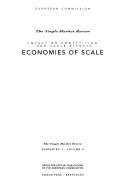| Listing 1 - 10 of 75 | << page >> |
Sort by
|
Book
Year: 2011 Publisher: Washington, D.C., The World Bank,
Abstract | Keywords | Export | Availability | Bookmark
 Loading...
Loading...Choose an application
- Reference Manager
- EndNote
- RefWorks (Direct export to RefWorks)
The authors develop a framework for studying trade in horizontally and vertically differentiated products. In their model, consumers with heterogeneous incomes and tastes purchase a homogeneous good and make a discrete choice of quality and variety of a differentiated product. The distribution of preferences generates a nested-logit demand structure such that the fraction of consumers who buy a higher-quality product rises with income. The model features a home-market effect that helps to explain why richer countries export higher-quality goods. It provides a tractable tool for studying the welfare consequences of trade and trade policy for different income groups in an economy.
Book
Year: 2011 Publisher: Washington, D.C., The World Bank,
Abstract | Keywords | Export | Availability | Bookmark
 Loading...
Loading...Choose an application
- Reference Manager
- EndNote
- RefWorks (Direct export to RefWorks)
The authors propose a theory of task trade between countries that have similar relative factor endowments and technological capabilities but may differ in size. Firms produce differentiated goods by performing a continuum of tasks, each of which generates local spillovers. Tasks can be performed at home or abroad, but offshoring entails costs that vary by task. In equilibrium, the tasks with the highest offshoring costs may not be traded. Among the remainder, those with the relatively higher offshoring costs are performed in the country that has the higher wage and higher aggregate output. The paper discusses the relationship between equilibrium wages, equilibrium outputs, and relative country size and examines how the pattern of specialization reflects the key parameters of the model.
Book
ISBN: 110856190X 1108555020 1108453090 Year: 2018 Publisher: Cambridge : Cambridge University Press,
Abstract | Keywords | Export | Availability | Bookmark
 Loading...
Loading...Choose an application
- Reference Manager
- EndNote
- RefWorks (Direct export to RefWorks)
The main thrust of this Element is a critical assessment of the theory and evidence concerning the sources of scale effects. It is argued that the analysis of static scale effects is important because scale effects are embedding in our world, and new technologies associated with an evolving economy often allow their exploitation when they cannot be exploited in less technically advanced and smaller economies. So, although static equilibrium theory is not a good vehicle for studying economic growth, showing how scale effects operate when output varies with given technology helps us to understand the scale effects that occur when output rises as a result of economic growth, even though that is typically driven by technological change.
Economies of scale. --- Economies of size --- Increasing returns --- Scale, Economies of --- Size, Economies of --- Big business --- Costs, Industrial --- Diminishing returns
Book
ISBN: 022626176X 9780226261768 9780226261621 022626162X Year: 2015 Publisher: Chicago
Abstract | Keywords | Export | Availability | Bookmark
 Loading...
Loading...Choose an application
- Reference Manager
- EndNote
- RefWorks (Direct export to RefWorks)
The rise of America from a colonial outpost to one of the world's most sophisticated and productive economies was facilitated by the establishment of a variety of economic enterprises pursued within the framework of laws and institutions that set the rules for their organization and operation. To better understand the historical processes central to American economic development, Enterprising America brings together contributors who address the economic behavior of American firms and financial institutions-and the associated legal institutions that shaped their behavior-throughout the nineteenth and early twentieth centuries. Collectively, the contributions provide an account of the ways in which businesses, banks, and credit markets promoted America's extraordinary economic growth. Among the topics that emerge are the rise of incorporation and its connection to factory production in manufacturing, the organization and operation of large cotton plantations in comparison with factories, the regulation and governance of banks, the transportation revolution's influence on bank stability and survival, and the emergence of long-distance credit in the context of an economy that was growing rapidly and becoming increasingly integrated across space.
Business enterprises --- Commercial credit --- Bank loans --- History --- Finance --- Bankruptcy. --- Banks. --- Governance. --- Growth. --- Incorporation. --- Manufacturing. --- Plantations. --- Scale economies.

ISBN: 9282788040 0749423374 Year: 1997 Volume: v.4 Publisher: Luxembourg : London : Office for official publications of the European Communities, Kogan PageEarthscan,
Abstract | Keywords | Export | Availability | Bookmark
 Loading...
Loading...Choose an application
- Reference Manager
- EndNote
- RefWorks (Direct export to RefWorks)
Economies of scale --- -Single market programme --- 338.5 --- Economies of size --- Increasing returns --- Scale, Economies of --- Size, Economies of --- Big business --- Costs, Industrial --- Diminishing returns

ISBN: 3790811238 3642470300 Year: 1998 Publisher: Heidelberg Physica
Abstract | Keywords | Export | Availability | Bookmark
 Loading...
Loading...Choose an application
- Reference Manager
- EndNote
- RefWorks (Direct export to RefWorks)
The analysis of this volume represents an attempt to apply modern mathematical techniques to the problems arising from large and significant indivisibilities. While the classical microeconomic theory refers to assumptions about the convexity of production sets and consumer preferences, this book directs the attention to indivisible commodities. It investigates the influence of the assumed indivisibilities of factors and goods on the results of the microeconomic theory of the firm, the theory of the household and market theory.
Economies of scale --- Equilibrium (Economics) --- Mathematical models. --- Microeconomics. --- Price theory --- Economics --- Economies of size --- Increasing returns --- Scale, Economies of --- Size, Economies of --- Big business --- Costs, Industrial --- Diminishing returns
Book
ISBN: 9282110249 9282105695 Year: 1974 Publisher: Paris OECD. Economic research centre
Abstract | Keywords | Export | Availability | Bookmark
 Loading...
Loading...Choose an application
- Reference Manager
- EndNote
- RefWorks (Direct export to RefWorks)
This Round Table examines the structure and performance of the road haulage industry, whether there are any economies of scale within it, and the influence of demand on its structure and operations.
Transport --- Transportation, Automotive --- Economies of scale --- Economic specialization --- Business & Economics --- Transportation Economics --- Specialization, Economic --- Economics --- Division of labor --- Economies of size --- Increasing returns --- Scale, Economies of --- Size, Economies of --- Big business --- Costs, Industrial --- Diminishing returns --- Automotive transportation --- Highway transportation --- Motor carriers --- Motor transportation --- Road transportation --- Automobiles --- Social aspects --- 656.1 --- 656.1 Road transport --- Road transport
Book
ISBN: 1853390712 Year: 1990 Publisher: London Intermediate Technology Publications
Abstract | Keywords | Export | Availability | Bookmark
 Loading...
Loading...Choose an application
- Reference Manager
- EndNote
- RefWorks (Direct export to RefWorks)
Appropriate technology --- Economies of scale --- 658.11 <1-772> --- 658.11 <1-772> Kinds and forms of enterprise--Onontwikkelde, onderontwikkelde gebieden --- Kinds and forms of enterprise--Onontwikkelde, onderontwikkelde gebieden --- Economies of size --- Increasing returns --- Scale, Economies of --- Size, Economies of --- Big business --- Costs, Industrial --- Diminishing returns --- Alternative technology --- Appropriate technologies --- Soft technology --- Technology --- Economic aspects --- Economic production
Book
ISBN: 1462325742 1452766398 1281305189 1451897480 9786613778475 Year: 1999 Publisher: Washington, D.C. : International Monetary Fund,
Abstract | Keywords | Export | Availability | Bookmark
 Loading...
Loading...Choose an application
- Reference Manager
- EndNote
- RefWorks (Direct export to RefWorks)
A key obstacle to fundamental tariff reform in many developing countries is the revenue loss that it ultimately implies. This paper establishes a simple and practicable strategy for realizing the efficiency gains from tariff reform without reducing public revenues, showing that for a small open economy, a cut in tariffs combined with a point-for-point increase in domestic consumption taxes increases both welfare and public revenues. Increasingly stringent conditions are required, however, to ensure unambiguously beneficial outcomes from this reform strategy when allowance is made for such important features as nontradeable goods, intermediate inputs, and imperfect competition.
Macroeconomics --- Taxation --- Models of Trade with Imperfect Competition and Scale Economies --- Trade Policy --- International Trade Organizations --- Taxation, Subsidies, and Revenue: General --- Price Level --- Inflation --- Deflation --- Business Taxes and Subsidies --- Macroeconomics: Consumption --- Saving --- Wealth --- Public finance & taxation --- Tariffs --- Consumption taxes --- Consumer prices --- Producer prices --- Consumption --- Taxes --- Prices --- National accounts --- Tariff --- Spendings tax --- Economics --- Ethiopia, The Federal Democratic Republic of
Book
ISBN: 146238627X 1455291897 1281186317 1455225185 9786613777317 Year: 1994 Publisher: Washington, D.C. : International Monetary Fund,
Abstract | Keywords | Export | Availability | Bookmark
 Loading...
Loading...Choose an application
- Reference Manager
- EndNote
- RefWorks (Direct export to RefWorks)
This paper provides a theoretical model to address the issue of how industrialization affects the structure of international trade. Considering both horizontal and vertical product differentiation, the model shows that intra-industry trade increases when product quality improvement emerges in a developing country and when a difference in relative factor endowments between a developed and a developing countries shrinks. To promote understanding of the conclusions of the model, the paper also uses actual trade data between Japan and Indonesia and between Japan and Korea.
Investments: Commodities --- Exports and Imports --- Economic Development --- Industries: Manufacturing --- Models of Trade with Imperfect Competition and Scale Economies --- Empirical Studies of Trade --- Industry Studies: Manufacturing: General --- Agriculture: General --- Trade: General --- Industrialization --- Manufacturing and Service Industries --- Choice of Technology --- Manufacturing industries --- Investment & securities --- International economics --- Development economics & emerging economies --- Manufacturing --- Agricultural commodities --- Exports --- Imports --- Economic sectors --- Commodities --- Development --- International trade --- Farm produce --- Indonesia
| Listing 1 - 10 of 75 | << page >> |
Sort by
|

 Search
Search Feedback
Feedback About UniCat
About UniCat  Help
Help News
News